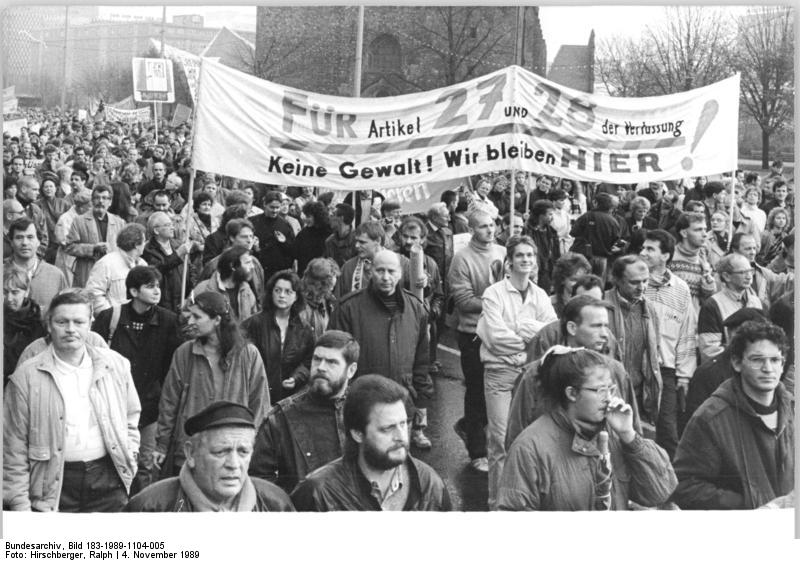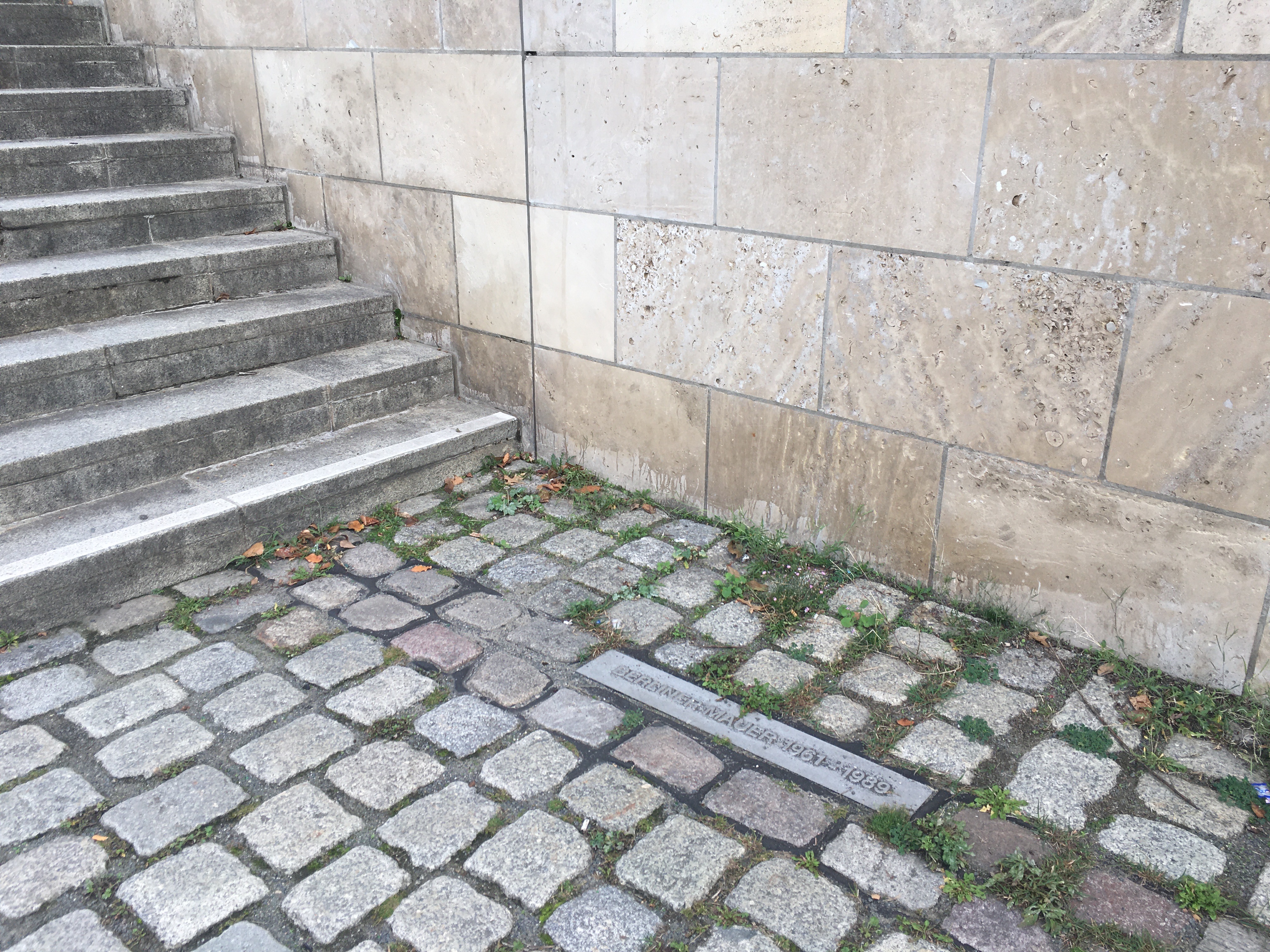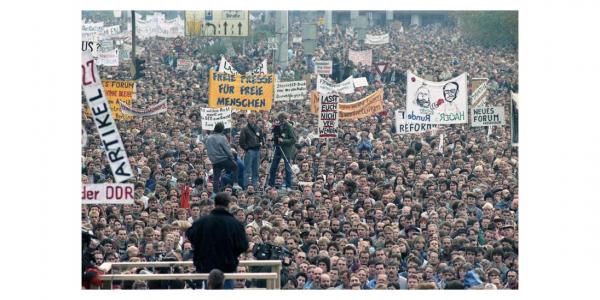Anika Walke is associate professor of history.
“As far as I know — effective immediately, without delay.”
Günter Schabowski, newly appointed Minister for Information of the GDR government, made history with this vague answer to a journalist’s question at 6:55pm on November 9, 1989. Effective that day, people heard, East German citizens could receive permission to travel abroad or even emigrate permanently. Because Schabowski had not paid attention to an embargo on this new regulation, and because he had not even read the law carefully, his statement preempted an orderly cross-border traffic that was supposed to allow for the long-desired freedom to travel for East German citizens. Instead, the Berlin Wall crumbled. Immediately after this statement was broadcast to East and West German audiences, people made their way to the border checkpoints in the city of Berlin and demanded permission to cross. Four hours later, border guards who had been taken by surprise by the evening’s events, gave in and opened the barriers.
What we now commemorate as the Fall of the Berlin Wall, was, while hugely symbolic, the result of a rhetorical fumble and not inevitable. Just days before, the East German government had prepared for the potential breach of the border by heavily arming the police. On November 4, 1989, up to 500,000 people had attended a demonstration and rally in Berlin — the first and only such event that had not been organized by state authorities and thus marked a departure from restrictions to the use of public space in the GDR. The meeting, billed as a defense of the GDR constitution and especially the rights to freedom of the press, opinion and assembly, had demonstrated that criticism of the GDR was not necessarily meant to question the existence of the state, but the status quo.
“Imagine there is socialism, and nobody leaves.”
When writer Christa Wolf, one of 26 speakers at the rally, recited a banner used at many demonstrations that had swept the country for the past two months, people cheered. They, and surely millions glued to the TV where the rally was streamed live (again something that had never happened before), shared this sentiment. For years, political opponents, church activists, Punks, artists, writers, musicians and philosophers had called for democratization, for freedom of speech, for a right to privacy, and for freedom to travel abroad. They did not want to leave, but they wanted a better country — a better socialism.

To be sure, there were those who did want to leave. Thousands had applied for permission to emigrate, often rejected and abused instead. Throughout the summer of 1989, others had traveled to Hungary in hope of crossing over into Austria — a hope that for many was fulfilled when the Hungarian government opened the barbed wire. In September, thousands of others traveled to Prague and entered the grounds of the West German embassy, demanding to be released from East Germany. In late September, the GDR leadership agreed, providing sealed trains that carried the emigrants across GDR territory to the FRG. Along the way, hundreds tried to jump the trains but were hindered by armed police.
But there were also the many who took to the streets in September and October 1989, exclaiming, “We’re staying here!” The more famous slogan of “We are the people” (meaning that the government, ostensibly representing the people, was failing to do so and, therefore, illegitimate) made it into the history books. Often, it is benevolently placed next to “We are one people,” a slogan calling for the reunification of East and West Germany, which gained popularity in late November once the Wall was open. And yet, it was precisely the activism of those who had found the courage to speak up before that memorable fumble that laid the foundation for it: Pressure from the street had set in motion changes within the government, including the appointment of a minister for information — Schabowski — and urged the leadership to issue a new law on international travel.
Whether one sees the Fall of the Berlin Wall positively or negatively, it is only appropriate to remember that it was rather an end to, not the beginning of, a process that signaled the end of the GDR as it had existed for four decades. It thwarted the efforts of many who were proposing a so-called Third Way — insisting on the GDR’s sovereignty, which would offer the opportunity to shape a society built on principles of solidarity, social justice, individual freedom, freedom of movement and protection of the environment. Instead, a few days later West German politicians, economists and lobbyists began to discuss steps toward reunification and conditions for economic support to the East German lands — conditions that, many warned, could only be harmful to large parts of the population. Capitalist restructuring, drastic cuts to welfare and social support systems, and the return of real estate and land to pre-World War II owners spelled not only loss of social status and social security. This massive and often regressive transformation was experienced as a loss of self-worth and sense of belonging by citizens of the former GDR and would produce a new crisis of political representation.
Thirty years on, this insight is clearer than it was at the time. The rise of the AfD, the rightwing Alternative for Germany party, has been the subject of much writing and debate. Often, a supposedly innate East German racism and a proclivity toward authoritarianism are foregrounded. Curiously, the recent election gains for AfD come nearly thirty years after the reunification. Mass unemployment, rent increases, poverty wages and witnessing the disassembly of production facilities during this intervening period might have more explanatory potential for the tendency to turn against refugees, immigrants and Jews than the pre-1989 experience of real existing socialism. There is growing awareness that neglecting the aftermath of the fall of 1989 was a mistake, and that the continued divisions and rifts between “East” and “West” Germany are in large part a result of just that, yet this reckoning is likely unable to reverse the damage.

Commemorating and celebrating November 9 is not only risky because it coincides with commemorating the Reichspogromnacht in 1938, when thousands of synagogues, Jewish businesses and other structures in Germany were set on fire and thousands of Jewish men arrested and held in concentration camps solely because they were Jewish, or the anniversary of the (failed) coup d’état orchestrated by Adolf Hitler and General Erich Ludendorff in 1923 that would help establish Hitler as a central political figure in Weimar Germany. It also comes at the risk of forgetting the before and after. A fixation on anniversaries, especially on those that are ideologically overdetermined, often covers up the complexity of history. Focusing on the flag-waving men and women who scaled the Berlin Wall on that fall night of 1989 makes it easy to neglect the power relationships that steamrolled the protesters of November 4, and which still today suggest that the Fall of the Berlin Wall marks the inevitable victory of capitalism.
Headline photo: Demonstration in East Berlin, November 4, 1989. Bundesarchiv, Bild 183-1989-1104-437 / Settnik, Bernd / CC-BY-SA 3.0




